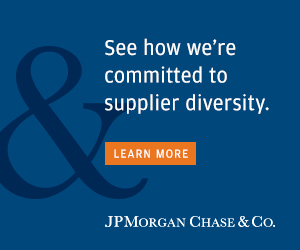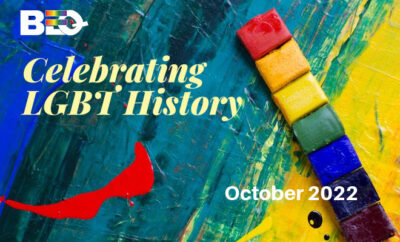
Corporate
Pacific Gas & Electric is All.In. For LGBT Business
by Melissa Lowery
Pacific Gas & Electric Company’s Supply Chain Responsibility team adopted “All.In.” as their tag line in 2015 to convey the total commitment PG&E has to supplier diversity. This commitment and the team’s passion is evidenced in their overall supplier diversity spend of $2.5 billion in 2015, equating to 44 percent of the company’s spend for the year.
A history of LGBT business equality
Being “All.In.” means reaching forward to embrace new opportunities to create a fully inclusive supply chain, which is exactly what PG&E did in 2012 by becoming the first utility to include LGBT suppliers in its Supplier Diversity Program. Starting with a formal policy to include LGBT suppliers, the supply chain organization added LGBT to all of its sourcing processes, and asked its prime suppliers to include LGBT suppliers in their subcontracting initiatives.
The company also supported the passage of California Assembly Bill 1678 in 2015, which requires California public utilities to extend to LGBT enterprises the same business opportunities granted to women-, minority- and disabled veteran-owned companies.
PG&E hosted the inaugural 2015 LGBT Business Builder Workshop, held in San Francisco in collaboration with the Small Business Administration, the National Gay and Lesbian Chamber of Commerce (NGLCC), the Golden Gate Business Association (GGBA) and the California Public Utilities Commission. The workshop was designed to remove barriers and increase access to strategic growth opportunities for America’s LGBT businesses.
For the past 13 years, PG&E has been named as one of the best places to work by the Human Rights Campaign, the largest civil rights organization working to achieve equality for LGBT Americans. Over this period, PG&E has received a perfect 100 percent rating on the organization’s Corporate Equality Index for their strong commitment to embrace diversity and inclusion. In 2016, PG&E’s PrideNetwork, one of the first LGBT employee resource groups in the nation, celebrated its 30th anniversary.
Setting – and achieving – extraordinary goals
The secret to PG&E’s success in supplier diversity as a whole and LGBT business equality in particular is the integration of supplier diversity into the company’s core business initiatives. Every department at PG&E, including the C-suite, is committed to supplier diversity and maximizing the benefits of diverse suppliers in the supply chain.
“We’re not approaching supplier diversity as a social good or as a brand enhancement or as a marketing initiative,” said Joan Kerr, director of Supply Chain Responsibility, “but rather as a specific business goal that receives the same resources, planning and metrics as any other business initiative. If it’s just a slogan or part of your value system, as laudatory as that might be, it’s not going to have the same traction as other elements of the business plan.”
The supplier diversity team meets with the C-suite and team leaders to set specific numerical diverse spend goals for the year with a current internal target of an impressive 42 percent in total diverse spend. To achieve this objective, each of PG&E’s top officers is accountable for his or her team contributing to the supplier diversity goal, but Kerr goes one step further to encourage peak results.
“If you measure and publish the results of each officer’s performance against the overall goal, that really generates a lot of energy and focus that leads to maximum participation,” she said.
This company-wide commitment to supplier diversity is achieving extraordinary results. In 2015, PG&E exceeded its own ambitious goal, spending $2.5 billion with diverse business, a record 44 percent of the company’s overall spend.
“Having an ambitious goal is important,” Kerr said. “Continuing to focus on improvement is important. Having the resources, especially the staff that can actually help execute against this specific goal, helps everybody be successful.”
Getting to know LGBT suppliers
Four years after including LGBT business in their “All.In.” strategy, PG&E is building on its successes and identifying opportunities for LGBT suppliers. The journey of bringing in an entire new group of suppliers takes time, patience, and diligence and involves collaboration with several key stakeholder groups. Community based advocacy groups such as the NGLCC and the GGBA along with the Sacramento Rainbow Chamber of Commerce and the Silicon Valley Rainbow Chamber of Commerce have been critical partners to PG&E.
“These groups are educating the LGBT community about the fact that PG&E and other corporations are eager to benefit from the skills and talent of LGBT businesses,” Kerr said. “We are in the ‘getting to know you’ stage of development with our LGBT program. Kristen Hickey has done a great job as our team lead in co-producing several events – matchmakers, trainings and networking events – so we can see who’s out there and develop a portfolio of potential suppliers who are providing the products and services that we’re buying.”
The energy company is also developing new Tier 2 opportunities, working with prime suppliers to educate them about the availability of LGBT suppliers and encouraging primes to get involved with NGLCC and regional affiliates.
“Oftentimes small businesses are best poised to contribute as sub-contractors,” she noted, “so we want to make sure we’re making those introductions and connecting our primes with LGBT businesses. We’re encouraging them to get engaged with the national and regional councils and get to know LGBT businesses”
Setting up suppliers for success
PG&E is on track to double its LGBT supplier spend in 2016, with an emphasis on identifying more certified LGBT businesses in the core spend areas of gas and electric operations, so that this growth trajectory continues. Kerr’s team is also developing programs for suppliers to understand the requirements for doing business with PG&E, focusing on issues like safety, cyber security and sustainability. The training explains PG&E’s expectations in those areas and shows suppliers how to submit performance results with bids, in addition to standard information, so they are more competitive.
In addition to educating suppliers on the bidding process, PG&E wants to foster a focus on advanced technology among diverse suppliers.
“As technology is leap-frogging, regardless of what kind of business you have, in order to remain competitive and have the best prices, you have to ensure that you’re utilizing the best processes and tools,” Kerr said. “We really want our suppliers to be successful, so this is an area we’re focusing on in 2017 – how to help our diverse suppliers leverage technology and finding diverse suppliers that are already on the cutting edge of technology.”
The energy industry is evolving quickly, and PG&E is adopting new technologies to improve the safety, reliability and resiliency of the power grid while giving customers new options for managing their energy and saving money. PG&E’s “Grid of Things” is its vision for an electric grid that enables clean energy innovation now and in the years to come. Smart grid technologies are already enabling PG&E customers to take advantage of solar generation, electric vehicles and home energy management technologies.
To meet this need, PG&E is actively seeking diverse suppliers who are also on the cutting edge of technology. In fact, she just made a promising new connection at the NGLCC national dinner, where PG&E was named Corporation of the Year in recognition of the company’s commitment to LGBT business success.
“At the dinner last month, I met an LGBT certified supplier who focused on data analytics,” she said. “That’s exactly the kind of expertise that’s so important in today’s supply chain.”
Business Equality Pride (BEQPride) is the first publication from the BEQ family of national print and digital magazines exclusively addressing the needs of LGBTQ small-to-medium sized businesses, entrepreneurs and professionals.

















0 comments